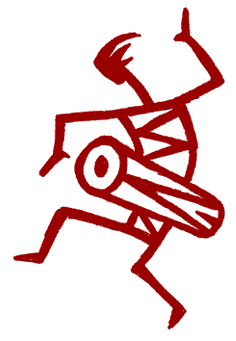

Thought of the Week Archives |
 |

|
|
|
May 19, 2003 Alignment - Part 2: The Path of Least Resistance In the game "Pick-up Sticks," you start with sticks that are neatly aligned in their box. You toss them on the floor and they fall into a tangled mess. Look at the stick on the very bottom. How can you get it out without disturbing the rest? By taking off the sticks at the top that are easiest to remove. Eventually the bottom stick will be easy to pick up. All the sticks will become, once again, aligned in the box. This is called taking the path of least resistance. This is the principle necessary to deal with the tangles and mis-alignments in our lives. We can take the path of least resistance and deal with the simplest issues - one at a time. If we try to tackle the huge, complex problems, we will upset the entire pile and end up feeling defeated. Many of our problems are complex and involve other people. These people often have their own neurotic reasons for being involved, and they will not just change because we wish them to. In fact, many people get uncomfortable when we change. Change can feel frightening. A dysfunctional web of behaviour is familiar, and most people prefer the "devil" we know to the devil we don't know. Like taking sticks off the pile, it is important to proceed gradually and carefully. Conscious change often requires two essential components - removing unhealthy things and adding things that are healthy. It is not enough just to cut dysfunctional elements, behaviours, and people out of our lives. We also need to strengthen ourselves with positive, life-supporting activities and friends in order to make changes stick. In behavioural psychotherapy, clients attempt to "remove the bad" by using willpower. Unfortunately this does not address the internal forces that drive us to behave in these dysfunctional ways. In primal, we express and resolve the core traumas that drive us. Without the traumatic drive, dysfunctional behaviours are much easier to move away from, and healthy, life-enhancing activities become much easier to develop and nurture. In all cases, however, the "pick-up stick" approach applies. In primal work, we deal with the emotions and issues that present themselves. We do not try to dig out deeper issues that we suspect are there. Eventually, like the bottom stick in the pile, these deeper issues will appear for the "picking." With physical health, relationships, finances, work, and other present-day problems, the path of least resistance is also useful. It is much more effective to look at the toxic, energy-draining elements in your life and deal with the easiest one first. When one element is taken care of, look again for the easiest one and deal with it. In this way, all you ever deal with is the easiest problem. In Chapter 64 of the Tao Te Ching, Lao Tzu states that, "The journey of a thousand miles starts with a single step." One step at a time, one stick at a time, one problem at a time. It may seem obvious, but many of us do not proceed in this way. Alignment is our natural state. All we have to do is assist the process of re-alignment by resolving problems and engaging solutions one at a time. Water follows the path of least resistance and always finds its way to the ocean. In the same way, we can find our way back to a full and healthy life. |